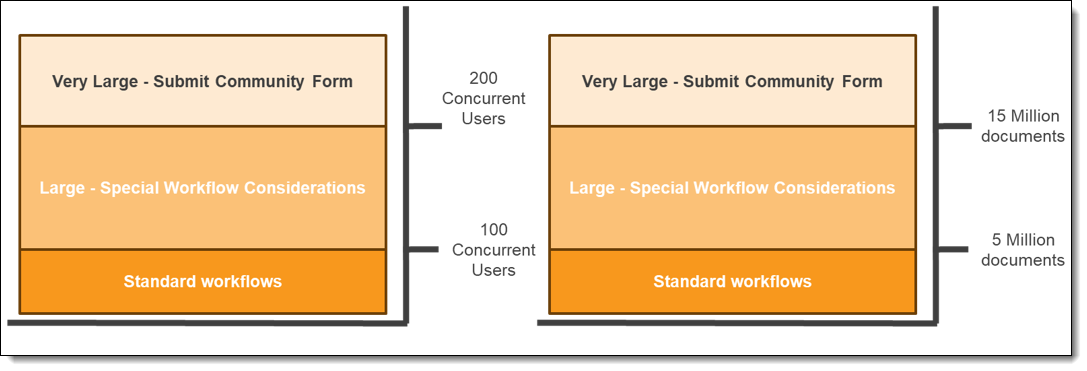Last date modified: 2025-Aug-13
Recommendations for managing large and very large workspaces in RelativityOne
The management of very large and complex workspaces requires an advanced level of knowledge and expertise as these workspaces generally bring a new set of challenges and potential complications. As an administrator, you should know the best approach for identifying and addressing performance and workflow complications that may arise when managing very large or complex workspaces in RelativityOne.
The following graphic breaks down how document count and the number of users determines if a workspace is large, very large, or standard:
A Second Request would qualify as a large or very large workspace; this is a comprehensive document, data, and interrogatory request issued by the Department of Justice (DOJ) or Federal Trade Commission (FTC). A Second Request tolls the agency's statutory time limit to complete its review of a transaction until each party has certified that it has substantially complied with the Request. The DOJ or FTC may issue a Second Request if the agency cannot resolve all of its concerns about the likely competitive effects of the transaction during this initial investigation period.
Below are best practices and considerations for the management of workspaces that meet these conditions, including guidance on the self-management of workflows and when to contact Relativity for assistance.
What's New, Release Notes, and Known Issues
For descriptions of new and updated functionality that could impact your workspaces, see the following:
Identifying a need to scale and RelativityOne’s automated response
Any workspace can be overwhelmed by excessive queries, index builds, overly complex searches, or having too many users logged in. When these workflows are performed in very large or complex workspaces, however, minor issues can be compounded, and resources are put under stress, causing actions to take minutes instead of seconds. The following issues may impact a workspace unnecessarily or cause poor responsiveness:
- Adding and removing fields.
- Overall slowness caused by too many fields being used within the document object.
- Trying to complete excessively complex searches.
- Having a large number of folders.
- Mass edits or coding a significant number of documents within a workspace.
- Direct SQL user actions or on a database server.
We recommend that your organization becomes familiar with workflow recommendations for very large workspaces and implement them as soon as possible to minimize resource contention and performance impacts. For more information on best practices, please visit Workflow solutions for very large workspaces.
Proactive Monitoring of RelativityOne Environments
RelativityOne Site Reliability and engineering teams conduct proactive monitoring and oversight to ensure the overall health of RelativityOne environments. Active alerts provide feedback on availability, capacity, response time and errors of the features and infrastructure that support RelativityOne.
When health or performance tolerances are exceeded, RelativityOne teams partner together to actively respond, investigate, and restore health to RelativityOne components.
Contacting RelativityOne in advance for upcoming large and complex projects
In addition to the automatic measures within RelativityOne to react to unexpected increases in resource utilization due to very large workspace conditions, customers should proactively notify Relativity of incoming very large and/or complex projects.
To contact Relativity and request a project scoping call and proactive capacity review, visit the Incoming Project Details: RelativityOne form available on the Community site. When submitting the request, information regarding expected size, specific workflows of interest, and expected number of concurrent reviewers should be provided to ensure we have the necessary information by which to consult, address, and make recommendations for an optimal experience in RelativityOne. Proactive partnership is key to the ongoing success of these workspaces.








